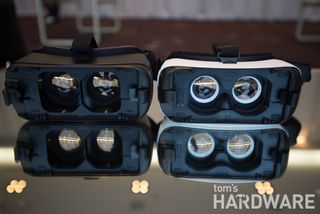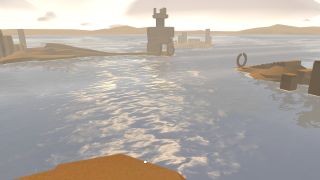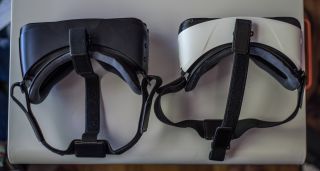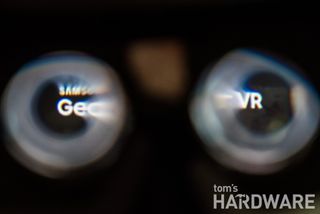New Samsung Gear VR Refines But Doesn't Revolutionize
Stuck Between Generations
When Samsung launched the Galaxy Note 7 with a microUSB port, many people blamed the Gear VR for holding back the company from adopting the newer USB Type-C standard. With more than a million headsets sold, how could Samsung justify a new interface that would render all those devices incompatible?
With the launch of a new Gear VR, Samsung finally has the answer. The new mobile VR system looks similar to its predecessor, except for its dark blue and midnight colors, but it hides a number of significant improvements. Chief among them is a clever new system of interchangeable adapters that lets you swap microUSB and USB-C compatibility, keeping the new Gear VR compatible with Samsung’s older phones, but also letting it connect to the new Note 7 (the first Samsung device to sport USB-C).

Other than this new trick, the updated Gear VR also has an improved touchpad, a number of refinements to fit and comfort, and better lenses with a wider field of view. The new headset also feels sturdier, though it comes at the cost of being slightly heavier
Improved interface and new compatibility aside (and that interchangeable adapter really is an engineering marvel), is the new Gear VR worth an upgrade?
Comparing Realities
I’ve been thinking of this new Gear VR as the second edition, but a Samsung rep pointed out that they think of it as the third, counting the “Innovator Edition.” If Samsung wants to get technical, the case can also be made that this is in fact the fourth Gear VR, as there were in fact two Innovator Editions (SM-R320 and R321). All of this is to say that when I refer to the “new Gear VR”, I’m talking about the dark blue edition released in 2016, and by “old Gear VR,” I’m referring to the white device that was the first consumer edition (SM-R322, released 2015).

My goal here was to compare the two Gear VR headsets to see what improvements have been made. In an attempt to eliminate variables, I had to resort to using a Galaxy Note 5 as the phone driving the two Gear VR systems. I did my initial testing of the new Gear VR with a Galaxy Note 7, but although the new Gear VR can adapt to fit the micoUSB port on the Note 5, the old Gear VR can’t accommodate the Note 7’s USB-C port.
Despite being a year old, the Note 5 still performed admirably, though I can say with confidence that the Note 7 is the ideal phone for use in the Gear VR. The display appears slightly clearer and more vibrant than the Note 5 (in fact, the Note 7 has possibly the best screen I’ve ever seen on a phone), and the Snapdragon 820 processor made for a smooth experience without the overheating problems that plagued earlier Galaxy phones.
Stay on the Cutting Edge
Join the experts who read Tom's Hardware for the inside track on enthusiast PC tech news — and have for over 25 years. We'll send breaking news and in-depth reviews of CPUs, GPUs, AI, maker hardware and more straight to your inbox.
The Note 5 is no slouch of a device, though, still sporting a 5.7” AMOLED screen at a 2560 x 1400 resolution for a pixel density of 515 PPI. Having also used the old gear VR extensively with a smaller Galaxy S6 (same resolution, but with a 5.1” screen), I can report that the larger phone makes for a much better experience. The difference is noticeable, with the larger image filling more of your vision and helping with immersion, which is the entire point of VR.
So with Note 5 in hand, I fired up the old Gear VR. My plan was to go through a series of experiences and play a few games that rely on the Gear VR’s built in touchpad, and then swap to the new Gear VR and repeat the content. In total I spent about 3 hours in virtual reality, which was enough time to make me slightly cross-eyed and put the real world out of focus for a solid 10 minutes once I took the headset off.
The content I consumed during the test included Marvel’s Battle for Avenger's Tower experience, a brief animated fly-through a slow-motion fight scene; Sonar, a short horror film set on an asteroid; a few rounds of Suicide Squad: Special Ops, a wave defense game; Land’s End, a puzzle simulator from the creators of Monument Valley; and CCP’s Gunjack, a turret shooter set in space.

The Heat And The Cold
The first challenge was the Note 5’s tendency to overheat. This has been well reported, but the Gear VR puts a toll on a phone’s processor. In the mobile world, as a device heats up, software governors reduce the chipset’s frequency, reducing power draw at the expense of device speed. In normal applications, this generally means dropped frames or slower loading times, but in VR the slowdown makes the entire experience feel sluggish, choppy and disorienting.
I got my first overheat warning with the old Gear VR during Sonar, after only a few minutes in VR. I managed to finish the video, but when I tried to launch Suicide Squad, the phone stuttered to the point that it was nauseating and unplayable. I pulled the phone, waited ten minutes, and tried again. This time I made it two waves into the game before I received another overheat warning, and the game froze. After the third overheat, I hit upon a solution that Samsung almost certainly never intended: I put the Note 5 in the freezer and walked away for half an hour.
Remarkably, this worked, and I was able to play through the rest of my test with no problem.

A Whole New World
Moving on to the new system, I swapped the Gear VR’s connector to the included microUSB port to match my Note 5, but my phone didn’t immediately recognize the headset. I had to remove and reseat the port a few times, and try plugging the phone in two or three times before everything registered, but once I got going, there were no problems. The new Gear VR is definitely an improvement, and the differences were noticeable, but not extreme.

The lenses of the new Gear VR are also improved. In theory they’re supposed to provide a wider field of vision (or "FOV," now 101 degrees, up from 96), though without switching back and forth between the two headsets it was hard to notice. The biggest practical advantage of the wider FOV is that it pushes back the color-fringed areas of the image further into your peripheral vision. Both of the Gear VR systems suffer from bad chromatic aberration (rainbow-colored halos and fringes) around objects at the the edges of the image, but the wider FOV of the new Gear VR helped keep the center of the image free from this distortion. The lenses may also be a slightly higher-quality material, as the image seemed slightly brighter and sharper, even on the Note 5.
The new Gear VR is also a bit more comfortable and easy to fit. The top strap now adjusts only from one point, which makes it easier to fit to your head. (The old gear VR used Velcro adjustments at either end of the strap, which was sort of a pain to fine-tune.)

In a surprise for me, the touchpad on the side of the new Gear VR is also massively improved. The old Gear VR used a "+" shaped touchpad with a small metallic capacitive button in the middle to let you interact with menus and play games. I generally use the Gear VR with a controller, and doing this comparison reminded me of what a pain it is to actually try and interact with anything using the the touchpad on the older system.
On the old Gear VR, touching almost anywhere--not just on the middle button--generally registers an action, and simply trying to navigate the store in VR was such a frustrating odyssey of mis-registered gestures, switching screens while trying to select, and input errors that I nearly threw the headset across the room.

The new Gear VR does away with the + shaped pad and the central button and just has a touch-sensitive zone on the side of the headset. I had thought this would make input even more imprecise, but remarkably it’s a huge improvement. Without the D-pad shape, the Gear VR now registers gestures anywhere on its touch surface, and navigating menus and playing games is actually far easier and more elegant. Tapping selects, and swiping completes actions.
I can’t say whether it was the residual effects of my freezer treatment or some improvement of the new Gear VR (possibly more efficient sensors, or the larger frame allowing for better air circulation?), but in the hour or more I was playing games with the Note 5 on the new Gear VR, it never overheated. I also have yet to have any overheating problems with the Note 7.
But Will it Play Crysis?
If you already have a Gear VR and have been enjoying it, the new Gear VR won’t offer you anything substantially new. But if you have an old Gear VR, it drives you crazy, and you aren’t ready to shell out for a Vive or Oculus, then the new system might be appealing. And if you’ve never tried the Gear VR but are curious, the new system does fix many of the flaws of the original Gear VR and is an ideal entry point into VR for anyone with a Samsung phone.
Speaking of these mobile VR systems in general, the head tracking and input controls have gotten so good by now that you’re hardly aware you’re wearing a headset, but the image still leaves something to be desired. Even with Samsung’s 2560 x 1440 QHD screens, the pixels are clearly visible when the phone is only inches from your eyes and magnified by lenses. Much of the content also suffers from strong aliasing, with jagged lines and fuzzy text degrading the experience (though somehow Samsung avoids this in its own system menus, which are sharp and readable).

This is only worsened by the strong chromatic aberration, though as I mentioned, the new Gear VR doesn’t seem to suffer from that particular affliction as much. This isn’t to say you can’t still be blown away by an experience on the Gear VR; it just highlights some of the technical challenges of the system. The next generation of Galaxy phones, rumored to have 4k screens, will hopefully help the situation.
It’s not the hardware that’s the real weak point of the Gear VR ecosystem; it’s the content. The entire Gear VR system is still hamstrung by a lousy app and limited library. Outside of VR, the Oculus/Samsung app is almost useless, offering only the most basic storefront of content management. In the store itself, most of the “experiences” are only a few minutes long, and many games, some of them costing $5-10, can be completed in under 90 minutes.
The experiences can be engrossing (check out Gone and Colosse), but we’re all here for games, right? To that end, Lands End, Smash Hit, and Gunjack are about the only Gear VR games I can fully recommend. Maybe there are others that are fun, but considering the lack of demos, no preview videos, poor store descriptions, and being burned a few too many times by a $10 game with a cool name but terrible gameplay, I’m gunshy from trying too many at random.
Ultimately, the new Gear VR is as close to an ideal mobile VR system as you can currently get, though its potential is held back by the available content.
Correction 8/18/2016: This article mistakenly stated the new Gear VR's FOV as 110 degrees
-
Zapin It is cheaper, compatible with multiple phones, somewhat wider FOV and better controls. Decent improvement imo. The MicroSD cards can be used in the phones again also so it makes having a gearVR more worthwhile again also. As long as the screen resolutions are unchanged we cannot expect to see much difference between this one and older models however.Reply
Most Popular


